Nov 23, 2012 | cents, coins, Euro, foreign, fun
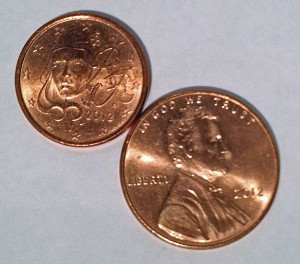
A 2012 one Euro cent pocket change find from France next to a 2012 Lincoln cent.
After doing an online search, I found that this is a 2012 coin from France.
As with all Euro coins, the reverse or common side depicts the same common Euro cent design that every country in the European Union uses and has used since Euro coins and currency were issued in 2002.

Le Triomphe de la République by sculptor Aimé-Jules Dalou at Place de la Nation in Paris features Marianne, the national emblem of France.
To the right of Marianne are the letters “R” and “F” for the République Française (French Republic). The design is surrounded by 12 stars symbolizing the the 12 nations in the European Union at the time of the design. It was designed by Fabienne Courtiade, an engraver from Monnaie de Paris (Paris Mint) whose name appears as “F COURTIADE” between the fourth and fifth star (assuming clock-like positions). This design is used on France’s one, two, and five Euro cent coins—all copper-plated steel coins.
If nothing else, I am a little ahead of the game since the coin is worth 1.3-cents at the current exchange rate. I hope you had a good Thanksgiving.
Image of the statue “The Triumph of the Republic” courtesy of Wikimedia Commons.
Jul 15, 2012 | commemorative, foreign, history, US Mint
For over 80 years since its founding, the U.S. Mint worked to increase production for it to be the sole supplier of coins for the young country. During that time, foreign coins, specifically the Spanish Milled Dollar (8 Real silver coin) was legal tender and served daily commerce. Congress revoked their legal tender status with the passage of the Coinage Act of 1857 making the U.S. Mint the sole supplier of coins in the United States.
Although the U.S. Mint was supposed to be building to supply the country with coins, it was taking on contract minting since it was the only entity with the ability to strike high quality medals. The first record of producing medals for someone other than the government was in 1833 for the American Colonization Society, a group whose purpose was to transport free-born blacks and emancipated slaves back to Africa and settle what today is known as Liberia.
Congress authorized the U.S. Mint to strike circulating coinage for foreign governments with the passage of the Act of January 29, 1874, “Provided, That the manufacture of such coin shall not interfere with the required coinage of the United States.”
The first legal tender coins produced for a foreign government was struck at Philadelphia for the Venezuelan government in 1875-1876 dated 1876-1877. The last circulating foreign coins were struck for Panama in 1983 when congress revoked the authorization because it began to interfere with domestic coin production.
The last time a coin was struck for a foreign country was in 2000 when the Leif Ericson commemorative silver coins were produced for domestic sales and for Iceland. The Iceland coin was struck with a face value of 1,000 Krónur.
Between the first coins struck for Venezuela and the Leif Ericson Commemorative Coin for Iceland, the U.S. Mint produced 1,127 coin types, not including varieties, for 43 countries. Coins were produced in gold, varied fineness of silver, bronze, brass, copper-nickel, nickel, steel, aluminum, and steel. Foreign coins were produced at Philadelphia, Denver, San Francisco, New Orleans, West Point, and Manila.
After the Philippines became a colony of the United States, the U.S. Mint established a branch mint in Manila in 1920. It is the only branch mint outside of the continental United States. Coins struck in Manila used the “M” mintmark making it the first foreign coin produced with a U.S. mintmark. The first foreign coins struck with a mintmark from one of the continental U.S. branch mints was the “P” that appeared on four different foreign coins in 1941. However, these were not the first time a foreign coin was identified as being struck in Philadelphia. In 1895, the word “PHILADELPHIA” was incorporated into the design of the reverse on the Ecuadorian 2 decimos coin.
Dec 21, 2011 | coins, COTY, foreign
On Monday, Krause Publications announce the winners of the 2012 Coin of the Year Awards. From these winners, judges will select an overall Coin of the Year winner which will be announced February 4, 2012, at the World Money Fair in Berlin, Germany. Voting for the People’s Choice Award will begin in early January with the winner also announced at the World Money Fair.
Krause reports that 95 coins issued in 2010 were nominated early in 2011 for consideration. The category winners are:
- Best Silver: Austrian Mint, 10 Euro Erzberg in Styria
- Most Popular Coin Design: Austrian Mint, Silver Philharmonic bullion coin
- Best Contemporary Event Coin: The German Federal Ministry of Finance, Silver 10 Euro celebrating German Unity
- Most Historically Significant Coin: Royal Canadian Mint, $100 gold coin commemorating the 400th Anniversary of the Hudson Bay Company
- Best Gold Coin: Royal Mint, £100k London Olymics Gold Coin
- Best Crown: Andorra Mint, 5 Dinar Brown Bear Pyrenees Silver Coin
- Most Artistic Coin: Israel Coins and Medals Corporation, Jonah in the Whale 2 NIS Silver Proof Coin
- Best Trade Coin:, San Marino, 2 Euro circulating coin
- Most Innovative Coin: Coin Invest Trust of Liechtenstein, 1500 Francs CFA Silver Proof featuring The Mecca Qibla Compass with magnetic spoon that points north.
- Most Inspirational Coin, Mont of Finland, Children and Creativity 20 Euro Coin; this coin is notable because it was the first theme for a Finnish coin selected by public vote. The coin was designed by Roope Määttä, an art student at the Kajaani Upper Secondary School, who describes his design as a reminder to always remember one’s roots.
For the second year in a row, no coin from the U.S. Mint was selected for any category.
Nov 9, 2011 | coins, COTY, foreign
 Krause Publications announced the Coin of the Year (COTY) nominations for 2012. Coins nominated for the 2012 COTY Award were released in 2010. According to Krause, nominees are judged by a panel of mint and museum officials, numismatic journalists, and individual experts from around the world. Winners are selected in each category (see below) and one coin is selected as COTY.
Krause Publications announced the Coin of the Year (COTY) nominations for 2012. Coins nominated for the 2012 COTY Award were released in 2010. According to Krause, nominees are judged by a panel of mint and museum officials, numismatic journalists, and individual experts from around the world. Winners are selected in each category (see below) and one coin is selected as COTY.
Once the category winners are announced, an online poll will be made available on their website numismaster.com for readers to vote on their favorite. The winner will be awarded the People’s Choice award.
Awards will be presented at the World Money Fair in Berlin, Germany during the first weekend of February 2012.
And the nominees are…
Most Historically Significant Coin
- Bank of Lithuania – Battle of Gruenwald, 500 Litas, gold, KM #173
- Royal Canadian Mint – 400th Anniversary of Hudson Bay, 100 Dollars, gold KM #997
- Coin Invest Trust acting as agent for the country of Cameroon, Shroud of Turin, 1000 Francs, silver, KM #38
- Israel Coins and Medals Corp, Old Akko, 10 New Shequalim, gold, KM #470
- British Royal Mint, 350th Anniversary of the Restoration of the Monarchy, 5 Pounds, silver, KM #1151a
- Mint of Poland acting as agent for Niue – Czar Peter the Great, One Dollar, Silver, KM #433
- Netherlands Mint – Max Havelaar, 5 Euro, silver, KM #294
- National Bank of Ukraine – 600th Anniversary of Gruenwald, 20 Hryvin, silver, KM #596
- National Bank of Portuagal, Torres Defense Line, 2.5 Euros, Silver, KM #800
- National Bank of Belarus, Battle of Gruenwald, 50 Roubles, Silver, KM #270
Best Contemporary Event Coin
- National Bank of Cyprus – 50th Anniversary of the Republic, 5 Euro, silver, KM #94
- Monnaie de Paris – Georges Pompidou Center, 10 Euro, silver, KM #1066
- Mint of Poland – 65th Anniversary of Auschwitz Libertion, 10 Zlotych, Silver, Y #713
- German Federal Ministry of Finance – Unity, 10 Euro, Silver, KM #290
- South African Mint – World Cup, 1 Rand, gold, KM #508
- Hungarian Mint – The Ballpoint Pen, 1000 Forint, copper nickel square, KM #818
- National Bank of Morocco – 35th Anniversary of Green March, 250 Dirhams, Y #132
- China Gold Coin Corp – 30th Anniversary of the Founding of the Shenzhen Special Economic Zone, 10 Yuan, silver, KM #1953
- Royal Canadian Mint, 75TH Anniversary of Canadian Banknotes, 500 Dollars, gold, KM #1007
- Bank of Latvia – 20th Anniversary of Modern Republic, 1 Lats, silver, KM #113
Best Gold Coin
- Perth Mint – Kangaroos fighting, 100 Dollars, gold, KM #1365
- Denmark National Bank – 70th Birthday of Queen Margaret, 1000 Kroner, gold, KM #939
- Israel Coins and Medals Corp. Tower of David Near the Jaffa Gate, 20 New Shequalim, gold, KM #467
- Mint of Finland – 150th Anniversary of Autonomy, 100 Euro, gold, KM #150
- British Royal Mint – London Olympics, 100 pounds, gold, KM #1162
- China Gold Coin Corp – Year of the Tiger, 5 ounce, 2000 Yuan, KM #1914
- National Bank of Argentina –World Cup, 10 Pesos, gold, KM #163
- National Bank of Ukraine – Panticapeum Ruins, 100 Hyrvin, gold, KM #597
- Italian State Mint –Arts of Europe – Sweden, 20 Euro, gold, KM #335
- Royal Canadian Mint – Prairie Crocus, 350 Dollars, gold, KM #1019
Best Silver
- National Bank of the Republic of Belarus – Battle of Gruenwald, 20 Rubles, silver, KM #239,
- National Bank of Russia –Saint George, 3 Roubles, Y #1214
- National Bank of Hungary – Orseg National Park, 5000 Forint, silver, KM #820
- Czech National Bank – Marriage of John of Luxembourg, 200 Korun, silver, KM #115
- National Bank of Lithuania –Brazai Castle, 50 Litu, silver, KM #170
- German Federal Ministry of Finance – Konrad Zuse, 10 Euro, silver KM #289
- Japan Mint – Aomori Prefecture100 yen, silver, Y #168
- Austrian Mint –Erzberg in Styria, 10 Euro, silver, KM #3185
- Italian State Mint – Giorgione 500th Anniversary of Death, 10 Euro, silver, KM #333,
- New Zealand Mint acting as agent for the country of Niue – Antilocapra Americana, One Dollar, silver, KM #234
Best Crown
- National Bank of Ukraine – Pottery, 10 Hryven, silver, KM #605
- New Zealand Mint acting as agent for the country of Niue – Sitting Bull, One Dollar, Silver, KM #394
- Perth Mint –Koala Coin, One Dollar, Silver, KM #1464
- Andorra Mint – Brown Bear, 5 Diners, Silver, KM #315
- Monnaie de Paris– Mother Teresa, 10 Euro, silver, KM #1695
- Kazakhstan Mint –Deer Buckle, 500 Tenge, silver, KM #179
- United States Mint – Boy Scouts, One Dollar, silver, KM #480
- Coin Invest Trust acting as agent for the country of Samoa – Flying Fox, 10 Dollars, silver, KM #173
- Coin Invest Trust acting as agent for the country of Togo – Sunbird, 1000 Francs, silver, KM #48
- China Gold Coin Corp. – Year of the Tiger, 50 yuan, silver, KM #1921
Best Trade
- Mint of Poland –August of 1980 Solidarity, 2 Zloty, Brass, Y#737
- United States Mint – Native American Dollar, One Dollar, Copper-nickel, KM #474
- National Bank of Argentina –Silver Sea, One Peso, Copper Nickel, KM #158
- National Bank of Denmark –Greenland Kayaking, 20 Kroner, Aluminum-bronze, KM #940
- Japan Mint – Gifu Prefecture, 500 Yen, Bimetallic, Gifu Prefecture
- Lithuanian Mint – Battle of Grunwald 600th Anniversary, 1 Litas, Copper-nickel, KM #172
- National Bank of India –Mother Teresa, 5 Rupees, Stainless Steel, KM #381
- National Bank of Venezuela – 200th Anniversary of Independence, 25 Centimos, Nickel-plated steel, Y #99
- National Bank of the Republic of San Marino – 500th Anniversary Death of Botticeli, 2 Euro, Bimetallic, KM #494
- Royal Australian Mint –Sheep Industry, 20 Cents, Copper-nickel, KM #1502
Most Popular
- Perth Mint – 50 Cents, silver, Kangaroo Bush Babies, KM #1456,
- United States Mint –Hot Springs National Park, 25 Cents, Copper nickel, KM #469
- Coin Invest Trust acting as agent for the country of Benin – Marijuana Coin, 100 CFA Francs, Copper-Nickel Silver plated, KM #53
- Royal Canadian Mint – Poppy Coin, 25 Cents, Nickel finish on Steel, KM #1028
- Austrian Mint – Philharmonic, 1.5 Euro, One Ounce, Silver, KM #3159
- Coin Invest Trust acting as agent for the country of Tuvalu – Brown Snake, One Dollar, Silver, KM #134
- Mint of Sweden – Wedding of Princess Victoria, 300 Kronor, Silver, KM #917
- Royal Mint – London Olympics, 5 Pounds, Sterling Silver, KM #1139a
- Perth Mint – Discover Australia Koala, 15 Dollars, Silver, KM #1405,
- Banco de Mexico – Morelos, 5 pesos, bimetallic, KM #923
Most Artistic
- Israel Coins and Medals Corp. – Jonah and the Whale, 10 New Shequalim, Silver, KM #477,
- Perth Mint – Sydney Cove Medallion, One Dollar, Silver, KM #1568
- Fiji – H.C. Andersen’s The Nightingale, One Dollar, Silver, KM #127
- Kazakhstan Mint – Pelicans, 500 Tenge, Silver, KM #177
- Italian State Mint – Aquileia, 10 Euro, Silver, KM #334
- Bank of Latvia – Amber Eye, 1 Lats, Silver, KM #109
- Royal Canadian Mint – Polar Bear, 3 Dollars, Silver gilt square, KM #1051
- China Gold Coin Corp – Chinese Grotto Art, 300 Yuan, Silver, KM #1950
- Coin Invest Trust acting as agent for the country of Palau – Tiffany Art Rococo, 10 Dollars, Silver, KM #252,
- Czech Mint – Alphonse Mucha, 200 Korun, Sterling silver, KM #114
Most Innovative
- Coin Invest Trust acting as agent for the country of Cook Islands – Obama/King, 5 Dollars, Silver, KM #729 &730
- Royal Canadian Mint – Year of the Tiger Hologram 150 Dollars, Silver, KM #979
- Coin Invest Trust acting as agent for the country of Niue – Seven Pointed Christmas Star, One Dollar, Silver, KM #422
- Coin Invest Trust acting as agent for the country of Palau – Dealer Button Insert with Playing Cards, One Dollar, Silver, KM #307
- Coin Invest Trust acting as agent for the country of Ivory Coast – Qibia Compass, 1500 Francs, Silver, KM #7
- Japan Mint – Sakamoto, 1000 Yen, Silver, Y #160, First Effigy of a Real Person
- Perth Mint acting as agent for the country of Tuvalu – Gustav Mahler, One Dollar, silver, KM #124, Depicts Musical Score
Most Inspirational
- Royal Australian Mint –Fred Hallows Inspirational Australians – Healthcare, One Dollar, Aluminum Bronze, KM #1496,
- New Zealand Mint acting as agent for the country of Cook Islands – Windows of Heaven, 10 Dollars, Sterling Silver, KM #1258
- Mint of Poland – 30th Anniversary of Solidarity, 10 Zloty, Silver, KM #738
- Austrian Mint – Barron Clemons Von Pirquet Children’s Clinic, 50 Euro, Gold, KM #3194
- Royal Mint – London Olympics 2012 – Olympic Strength, 5 Pounds, Silver, KM #1155
- Royal Canadian Mint – Remembrance Day Poppy, One Dollar, Silver, KM #1050
- Andorra Mint –Gabriel and Mary Christmas Coin, 25 Diners, Gold, KM #288
- Mint of Finland – Children and Creativity, 20 Euro, Silver, KM #1532
Oct 26, 2011 | foreign, gold, video
Early this morning U.S. time, the Perth Mint unveiled the world’s largest gold coin. The 1 Tonne Gold Kangaroo Coin is made from 99.99-percent pure gold, weighs one tonne (1,000 kilograms or 2,204.62 pounds), is 80 centimeters (31.49 inches) in diameter, and 12 centimeters (4.72 inches) thick. The obverse features Queen Elizabeth II and the reverse features a Red Kangaroo. The coin has a face value of AU$1 million ($1.04 million U.S. Dollars) and contains $55.23 million in gold (at the spot price $1718 per troy ounce).
Perth Mint surpassed the effort by the Royal Canadian Mint whose 2007 CA$1 million face value coin, made with 99.999-percent pure gold, and weighed only 100 kilograms.
Why did the Perth Mint do this? As a publicity stunt, of course. In a video produced by the Perth Mint (see below), the director said that it will be part of their exhibit for the 100,000 people per year who come to visit their facility. Certainly, the chance to see the World’s Largest Coin will be an attraction that will increase the number of visitors.
You can see how the Perth Mint made the coin in their video below.
Jul 11, 2011 | coins, commemorative, foreign
Long before the invention of electricity, before steam powered everything, and even before the perfection in the forging of iron and steel to make manual machines, coins were hammered by strong men in order to impress the image on the coinage metals.
Hammered coins were struck from ancient times until the screw coin press was invented by German silversmith Max Schwab around 1550. Hammered coins were struck by frost placing a coin blank on a stationary die (anvil die) that was attached or sunk into a log or another hard surface. The anvil die produced the reverse image. Then, holding the obverse die (trussel) in one hand, the coiner swung the hammer and forced the dies into the coin blank. The pressure from the hammering pushed the metal into the crevices of the dies including the stationary lower die to create the impression. It would take multiple hammer strikes in order to impress the image into the coin.
Hammered coins were rarely perfectly round. Aside from there being no collar surrounding the blank to keep it in place, Depending on the strength and skill of the coiner, the image may not transfer perfectly, the thickness may vary, the coin could exhibit flat edges, and striking errors. Collectors of these coins, mostly pre-17th century, find beauty in the character of each strike.
Monnaie de Paris (The Paris Mint) announced that it will create coins with the theme “From Clovis to the Republic” commemorating 1500 years of the history of France. The theme and design concepts were created by famed designer Christian Lacroix, Artistic Advisor of the Monnaie de Paris. The series will celebrate 15 kings, emperors, and presidents over five years that represents French history from Clovis I through Fraçois Metterand.
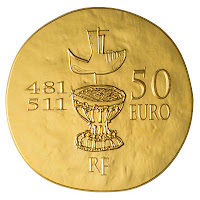
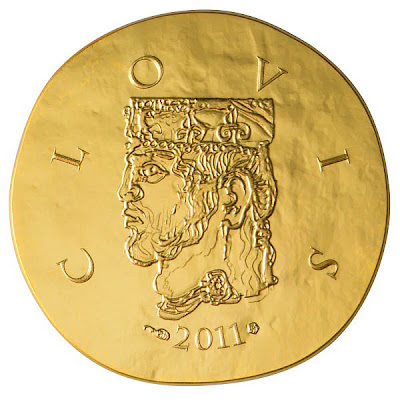 The first coin commemorate Clovis I. Clovis was the first King of the Franks. Clovis was the first Catholic king who united all of the Frankish tribes under one ruler. The second coin in the series features Charlemagne, the first Holy Roman Emperor and King of the Franks who created the first European-based empire. Both France and Germany traces their history back to Charlemagne.
The first coin commemorate Clovis I. Clovis was the first King of the Franks. Clovis was the first Catholic king who united all of the Frankish tribes under one ruler. The second coin in the series features Charlemagne, the first Holy Roman Emperor and King of the Franks who created the first European-based empire. Both France and Germany traces their history back to Charlemagne.
To give the coin a similar character to what might have existed during the time of Clovis and Charlemagne, Monnaie de Paris developed a method to make the coin appear to be hammer struck using modern minting equipment. The obverse of both coins has a portrait as it might have appeared at the time.
The reverse of the Clovis coin has a dove flying over a baptismal font representing his Catholic heritage.
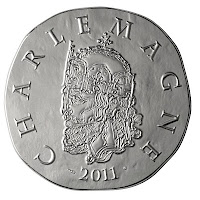
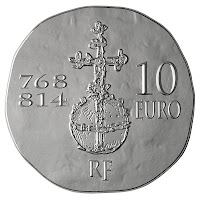 The reverse of the Charlemagne coin features a cross-bearing orb (globus cruciger in Latin), Charlemagne’s symbol of his sovereignty and power as the first emperor of the Holy Roman Empire.
The reverse of the Charlemagne coin features a cross-bearing orb (globus cruciger in Latin), Charlemagne’s symbol of his sovereignty and power as the first emperor of the Holy Roman Empire.
To the left of the reverse image are the years of their reign. To the right is the denomination. Below the image are the letters “RF” for République Français for “The French Republic.”
For each commemorative. Monnaie de Paris will be producing two coins. The 10 Euro coin is made from 22.2 grams of .900 fine silver and has a production limit of 20,000 coins at a cost of 65 € (54.35 € without VAT for outside of Europe). The 50 Euro coin is made from 8.45 grams (quarter-ounce) of .920 fine gold (22-Karat) and has a production limit of 1,500 coins and will cost 427 €. Those of us who live outside of Europe can find regional authorized distributors using a web search.
I like the idea to make commemoratives honoring historic figures designed and struck to look close to period pieces. It will be interesting to see how the people who vote for Coin of the Year reacts to these coins.
Coin images courtesy of Monnaie de Paris.
Jul 1, 2011 | bullion, foreign, gold, silver
 The People’s Bank, which governs the creation of coins in China, has announced that because the Panda coins are so popular they will be increasing production. In December, I wrote that the People’s Bank was plannning on a 10-fold increase in production. However, the recent announcement shows a somewhat smaller increase.
The People’s Bank, which governs the creation of coins in China, has announced that because the Panda coins are so popular they will be increasing production. In December, I wrote that the People’s Bank was plannning on a 10-fold increase in production. However, the recent announcement shows a somewhat smaller increase.
The largest increase will be in the 1⁄10 ounce and 1⁄20 ounce gold Pandas with a 4-fold increase. Silver 1 ounce Panda coins will double from last year. Mintages are being reported as follows:
| 2011 Pandas |
2010 Mintage |
New Mintage |
| 1 ounce Gold |
300,000 |
500,000 |
| ½ ounce Gold |
120,000 |
200,000 |
| ¼ ounce Gold |
120,000 |
200,000 |
| 1⁄10 ounce Gold |
120,000 |
600,000 |
| 1⁄20 ounce Gold |
120,000 |
600,000 |
| 1 ounce Silver |
3,000,000 |
6,000,000 |
In some forums, it has been suggested that this increase would mark the fourth generation of the silver Panda coins. One source described the generations as:
| Generation |
Weight |
Content |
Size |
| First Silver Panda Coins (1983-1985) |
27g |
.900 fine |
38.6 mm |
Sterling Silver Panda (1987)
one year issue |
1 troy oz |
.925 fine |
40 mm |
| Second Generation (1988-1999) |
1 troy oz |
.999 fine |
40 mm |
Third Generation (2000-2010)
Change in artists |
1 troy oz |
.999 fine |
40 mm |
Fourth Generation
Increased Production |
1 troy oz |
.999 fine |
40 mm |
Some have called silver the investment vehicle for the masses. Silver has a silky color that allows for striking designs to be very visible. Because silver is less dense than gold, a one ounce coin made from silver is larger than a one ounce gold coin. This means there is a larger surface area for beautiful designs, like the silver Panda.
Silver Panda coin image and production data courtesy of CGCI
Apr 21, 2011 | currency, foreign
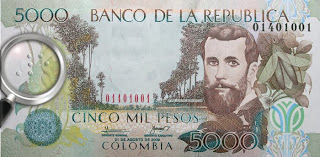 In March, the Banco de la Republica Colombia began circulating new 5,000 peso banknotes with the addition of the number 5 in Braille on the left side of the note. The Braille “5” is the only addition to the note that retains the previous design and security features.
In March, the Banco de la Republica Colombia began circulating new 5,000 peso banknotes with the addition of the number 5 in Braille on the left side of the note. The Braille “5” is the only addition to the note that retains the previous design and security features.
News stories from Colombia report that the COL$50,000 note include the number “50” in Braille in the bottom left next to the serial number. The COL$2,000 note includes the number “2” in Braille in the same location as the new COL$5,000 note.
The Colombian Central bank reports that it will be updating the rest of their banknotes to include the Braille numbers.
Colombian $5,000 note image courtesy of La República
Dec 29, 2010 | Britain, foreign, silver
Silver can bring out the best in nearly every design. Another silver coin worth collecting is the Britannia. After joining the United States and other countries to offer gold bullion coins in 1987, the Royal Mint celebrated the tenth anniversary of their program by introducing a £2 silver coin. Silver Britannias are struck in what is called Britannia silver, an alloy consisting of 958 parts per thousand silver. As a comparison, sterling silver consists of 925 parts per thousand silver. Comparatively, the American Silver Eagle contains 999 parts per thousand silver and the Canadian Maple Leaf consists of 999.9 parts per thousand silver. The balance of the alloy is usually copper.
Britannia was originally the Latin name that the Roman Empire gave to the island of Great Britain and its possessions. After the fall of the Roman Empire it had lost most symbolic meaning until the rise of British influence and being renewed during the time of Queen Victoria. Still depicted as a young woman with brown or golden hair, she kept her Corinthian helmet and her white robes, but now she held Poseidon’s three-pronged trident and often stood in the ocean, representing British naval power. She also usually held or stood beside a Greek hoplon shield which sports the British Union Jack. At her feet was often the British Lion, the national animal of England. Britannia first appeared on the farthing in 1672, followed by the halfpenny later the same year under Charles II.
When introduced in 1997, the Silver Britannia was minted with the official “hid Portrait” of HM Queen Elizabeth II on the obverse. This portrait was designed by Raphael Maklouf FRSA and shows the Queen with the Royal Diadem which she wears on her way to and from the State Opening of Parliament. The fourth official portrait of Her Majesty the Queen was introduced for all Commonwealth coinage in 1998. It is the work of sculptor Ian Rank-Broadley FRBS, FSNAD. Her Majesty is wearing the tiara which was used in an earlier coinage portrait by Arnold Machin. The Queen is shown facing right, in accordance with a tradition dating back to the seventeenth century, where successive monarchs face in alternative directions on the coinage.
From their introduction in 1987, the gold Britannia coins used the standing Britannia design on the reverse. On the tenth anniversary of the program and the introduction of the silver Britannia, a new deisign was created. The design was a figure of Britannia driving a chariot in the manner of Boudica was designed by Philip Nathan. Boudica, also know as Boadicea, was ruler of the Iceni tribe in eastern England and Queen of the Britons. She led her forces in revolt against the Romans and sacked Colchester, St. Albans, and London before being defeated by the Roman governor, Suetonius Paulinus. She died in the year 62 CE. This design was used in 1997, 1999, and 2006.
Following the successful launch of the silver Britannia coins, the Royal Mint returned to the standing Britannia design. Created by Philip Nathan, Britannia is depicted adorned in flowing robes standing proud in defense of Britain’s shores. The design recalls the design used on florins of Edward VII. this design also appeared in 2000, 2002, 2004, and 2006.
 With a few other designs mixed in, the 2010 is also a single year design designed by Suzie Amit who said that she wanted to portray Britannia as a strong and courageous looking but not overly warlike woman—more peaceful and protective. The coin is struck with shiny surfaces without contrast from frosted designs. Unfortunately, it made it difficult to image. Although this image does not capture its beauty, it is a very nice design and worthy of completing my one ounce Silver Britannia collection.
With a few other designs mixed in, the 2010 is also a single year design designed by Suzie Amit who said that she wanted to portray Britannia as a strong and courageous looking but not overly warlike woman—more peaceful and protective. The coin is struck with shiny surfaces without contrast from frosted designs. Unfortunately, it made it difficult to image. Although this image does not capture its beauty, it is a very nice design and worthy of completing my one ounce Silver Britannia collection.
American Silver Eagles, Chinese Pandas, and Great Britain Britannias are not only beautiful silver coins, but make a nice set to collect. Even with silver prices on the rise, they do make nice sets.
Dec 28, 2010 | bullion, foreign, silver
Some have called silver the investment vehicle for the masses. Even with the price rises, silver remains more affordable than gold and is more accessible than gold. Looking at the U.S. Mint product line, the consumer has more silver options than gold. At some point, the U.S. Mint will actually sell the American the Beautiful silver bullion coins that seems to have garnered a lot of attention.
Silver has a long history as being the most popular metals for coins. From Ancient Rome to the Spanish Pillar Dollars that became the basis of United States currency, silver has been the plentiful and desirable metal used for coinage. Once silver became the base metal of choice, the United States spent over 100 years manipulating the composition of coins and silver prices in an effort to support silver mining concerns of favored members of congress.
I like silver coins. Silver has a silky color that allows for striking designs to be very visible. Because silver is less dense than gold, a one ounce coin made from silver are larger than gold. For example, most gold bullion coins are around 28 mm while silver coins average 38-40 mm (the Canadian Maple Leaf is 38 mm). It translates to more surface area for beautiful designs.
I collect a few silver bullion coins. Aside from the American Silver Eagle in proof and bullion versions, I also collect Canadian Maple Leafs, British Britannias, and China Silver Pandas. Silver Pandas are very interesting. China has been minting the Panda Bullion coin since 1983. The obverse features a panda in various images in its environment. Every year (except 2002) features a different panda image depicted in its natural environment. The reverse is The Hall of Prayer for Abundant Harvests in the Temple of Heaven. There have been four versions of this design (1983-1991, 1992-1999, 2000, 2001-present).
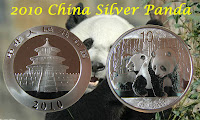 There have been three generations of Pandas and a single “different” issue. Generations are based on content and changes in design. The claim is that 2010 is the last year of the current generation since there may be a slight change in the works along with a significant increase in production. The People’s Bank, which governs the creation of coins in China, is planning for a 10-fold increase in production. It is conjectured that since the price of silver is so high that the premium they charge because of the popular designs can bring in more revenue. It is uncertain whether this will be a successful strategy because those who studied microeconomics will tell you that an increased supply without an increased demand will push the prices downward. The U.S. Mint discovered this a few years ago and reduced the number of products offered.
There have been three generations of Pandas and a single “different” issue. Generations are based on content and changes in design. The claim is that 2010 is the last year of the current generation since there may be a slight change in the works along with a significant increase in production. The People’s Bank, which governs the creation of coins in China, is planning for a 10-fold increase in production. It is conjectured that since the price of silver is so high that the premium they charge because of the popular designs can bring in more revenue. It is uncertain whether this will be a successful strategy because those who studied microeconomics will tell you that an increased supply without an increased demand will push the prices downward. The U.S. Mint discovered this a few years ago and reduced the number of products offered.
With the new information, one source, the generations have been described as:
| Generation |
Weight |
Content |
Size |
| First Silver Panda Coins (1983-1985) |
27g |
.900 fine |
38.6 mm |
Sterling Silver Panda (1987)
one year issue |
1 troy oz |
.925 fine |
40 mm |
| Second Generation (1988-1999) |
1 troy oz |
.999 fine |
40 mm |
Third Generation (2000-2010)
Change in artists |
1 troy oz |
.999 fine |
40 mm |
| Fourth Generation |
Projected for 2011: 10x increased production |
Recently, I picked up the 2010 Panda to keep my Third Generation collection complete. The Third Generation Panda designs are distinctive in being more realistic than previous designs with fine details as part of the design. Gone are the cartoon-like panda figures allowing this generation of panda designs to appeal to a wider audience. These are wonderful designs and something that shows off very well on the 40 mm silver planchet.











